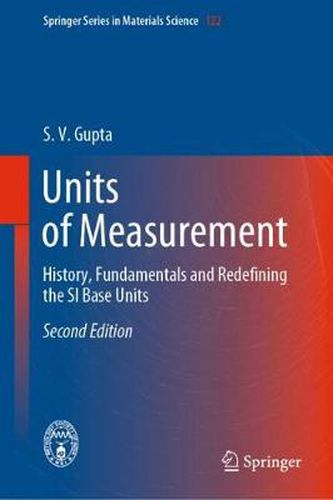Readings Newsletter
Become a Readings Member to make your shopping experience even easier.
Sign in or sign up for free!
You’re not far away from qualifying for FREE standard shipping within Australia
You’ve qualified for FREE standard shipping within Australia
The cart is loading…






This title is printed to order. This book may have been self-published. If so, we cannot guarantee the quality of the content. In the main most books will have gone through the editing process however some may not. We therefore suggest that you be aware of this before ordering this book. If in doubt check either the author or publisher’s details as we are unable to accept any returns unless they are faulty. Please contact us if you have any questions.
This book delivers a comprehensive overview of units of measurement. Beginning with a historical look at metrology in Ancient India, the book explains fundamental concepts in metrology such as basic, derived and dimensionless quantities, and introduces the concept of quantity calculus. It discusses and critically examines various three and four-dimensional systems of units used both presently and in the past, while explaining why only four base units are needed for a system of measurement. It discusses the Metre Convention as well as the creation of the International Bureau of Weights and Measures, and gives a detailed look at the evolution of the current SI base units of time, length, mass, electric current, temperature, intensity of illumination and substance.
This updated second edition is extended with timely new chapters discussing past efforts to redefine the SI base units as well as the most recent 2019 redefinitions based entirely on the speed of light and other fundamental physical constants. Additionally, it provides biographical presentations of many of the historical figures behind commonly used units of measurements, such as Newton, Joule and Ohm,
With its accessible and comprehensive treatment of the field, together with its unique presentation of the underlying history, this book is well suited to any student and researcher interested in the practical and historical aspects of the field of metrology.
$9.00 standard shipping within Australia
FREE standard shipping within Australia for orders over $100.00
Express & International shipping calculated at checkout
This title is printed to order. This book may have been self-published. If so, we cannot guarantee the quality of the content. In the main most books will have gone through the editing process however some may not. We therefore suggest that you be aware of this before ordering this book. If in doubt check either the author or publisher’s details as we are unable to accept any returns unless they are faulty. Please contact us if you have any questions.
This book delivers a comprehensive overview of units of measurement. Beginning with a historical look at metrology in Ancient India, the book explains fundamental concepts in metrology such as basic, derived and dimensionless quantities, and introduces the concept of quantity calculus. It discusses and critically examines various three and four-dimensional systems of units used both presently and in the past, while explaining why only four base units are needed for a system of measurement. It discusses the Metre Convention as well as the creation of the International Bureau of Weights and Measures, and gives a detailed look at the evolution of the current SI base units of time, length, mass, electric current, temperature, intensity of illumination and substance.
This updated second edition is extended with timely new chapters discussing past efforts to redefine the SI base units as well as the most recent 2019 redefinitions based entirely on the speed of light and other fundamental physical constants. Additionally, it provides biographical presentations of many of the historical figures behind commonly used units of measurements, such as Newton, Joule and Ohm,
With its accessible and comprehensive treatment of the field, together with its unique presentation of the underlying history, this book is well suited to any student and researcher interested in the practical and historical aspects of the field of metrology.